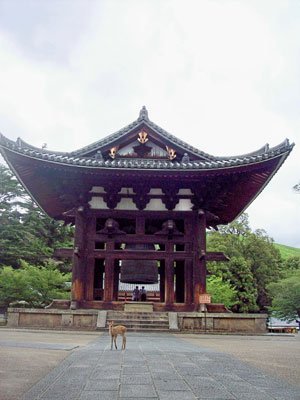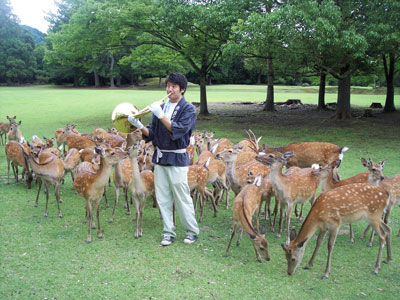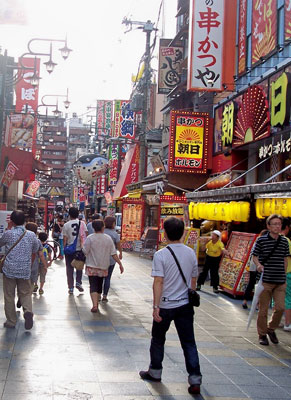Japan: Osaka
This item appears on page 62 of the January 2015 issue.
(Second of two parts)
The second part of my late-July 2014 journey to Japan’s Kansai region began with a morning stroll around Kinosaki, one of Japan’s famed hot springs resorts, where we had enjoyed the baths the previous night. Our small group of three journalists was on a week-long exploration of Kansai as guests of the Kansai International Tourism Promotion Center.
Izushi soba
Departing Kinosaki, we traveled by minivan through clean, green countryside punctuated by continuous small farming plots and greenhouses to Izushi to visit its historic Old Town. Our touring there included detailed exploration of a traditional-style Japanese theater that still holds performances.
Izushi is regarded by many to be the soba noodle capital of Japan. The primary reason for our visit was to get hands-on instruction in the fine craft of making soba noodles.
We gathered in a special room in a restaurant, where, starting with only soba flour, water and wooden spreading boards, we happily labored through each step of our instruction, including deftly cutting the noodles, with a little help from the soba master. As a reward, for lunch we enjoyed the noodles we had made.
Before departing Izushi, we visited the town’s most popular ice cream shop, where we were able to sample soba ice cream. It had a nutty flavor and was much tastier than I expected.
Osaka
On arrival in Osaka by rail, we checked into the beautiful, strategically located Hotel Nikko Osaka (1-3-3 Nishi-Shinsaibashi, Chuo-ku, Osaka-shi, Osaka, 542-0086, Japan; phone +81 6 6244 1111, www.jalhotels.com/domestic/kansai/osaka. In US/Canada, phone JAL Hotels at 800/645-5687), from where we could walk to most of the primary shopping and restaurant areas.
The rooms ($205-$320 for a double) were excellent and the breakfast buffet among the finest I have experienced. My breakfast table, both days, afforded good views of certain famous high-end stores directly across the street. I literally enjoyed breakfast at (well, near) Tiffany’s.
This viewing perch also provided fascinating people-watching experiences, with passersby ranging from high-fashion models to a serious senior hiking group dressed and equipped to the nines.
On our first night in the city we hit the streets, walking to a restaurant to try variations of okonomiyaki, the popular Osaka street food that you grill at your own table. In this cozy, unpretentious setting, we sampled what may have been my favorite meal of the journey.
Okonomiyaki is a savory pancake containing a variety of ingredients. Cabbage is a common base ingredient in most recipes, and patrons add vegetables, meats and seafood, depending on their preferences. I have to admit that I lost control with the great seafood, almost like a condemned man feasting on his last meal.
On to Nara
In the morning we traveled by train for 30 minutes to Nara, which, approximately 1,300 years ago, was the first international capital in Japan.
The city offers several must-see sights. These include the UNESCO World Heritage Sites of Kasuga Grand Shrine, Hōryū-ji Temple and the overpowering Great Buddha Hall in Tōdai-ji Temple, the largest wooden building in the world. I was enthralled by the gigantic, 50-foot-tall, 380-ton bronze statue of the “cosmic Buddha” or “universal Buddha.”
In the vast precincts of the complex are many other buildings waiting to be explored, including the Tōdai-ji Museum, which was completed in 2011. You could easily spend the better part of a day exploring the many attractions.
Earlier, in the same area, at expansive Nara Park we were treated to a unique event in which a deer caller played his horn and, over the next five minutes, deer began to appear, coming from all directions to receive food.
Fully protected by local ordinances, the small, spotted Japanese deer are living in the wild yet are quite tame. They are all around the park and temple perimeters, so it isn’t necessary to experience the herding event to see them.
Before returning to Osaka, we visited the Harushika Sake Brewery (4-1, Fukuchi in-cho, Nari-city, Nara-Ken, Japan 630-8381; phone 81 742 23 2255, www.harushika.com) for an educational sake tasting. I learned that sake comes in many forms, and I brought home a type that is both bubbly and rather sweet.
Osaka on foot
On my final day in Japan we were on the go, exploring the many pedestrian-only, covered shopping streets and malls in downtown Osaka. We particularly reveled in the varied produce displays.
My favorite area was Douguyasuji, a street lined entirely with kitchen stores. Located a couple of blocks southeast of Osaka’s Namba station, it has a sign at the entrance and is a great place to find culinary-oriented gifts and souvenirs.
Our group stopped for a final lunch together at the popular restaurant Kushiya Monogatari (6 Chrome-2-61 Shimaya Konohana Ward, Osaka, Osaka Prefecture 554-0024 Japan; phone 81 6 6468 7833, www.kushi-ya.com [in Japanese]), where we made tempura at our table. (The set price of a meal is $18, including drink and dessert.) Since I possess little restraint when it comes to tempura, I was fully topped off just as the time came to leave my traveling companions behind.
A few minutes later I boarded a train for the 30-minute ride to KIX, the strikingly attractive, user-friendly Kansai International Airport, to connect with my homeward flight.
Experiencing Japanese culture
SOAPBOX WARNING — My brief week in Japan was somewhat overwhelming in an unexpected yet very positive way.
We travel to learn. Experiencing a culture that genuinely places “we” above “me” as a behavioral norm, one that utilizes a conduit for courtesy and gratitude laced with smiles and good humor, provided a seriously uplifting revelation.
I reside in a land that today, for the most part, espouses an “It’s all about me. Me first” mind-set as a rationalized popular-culture standard. This journey to Japan clarified for me just how far we, and some other cultures as well, have fallen from grace in this regard.
Yes, I am most definitely generalizing, but if your instinct is telling you to question my comments, I invite you to spend a week or two in Kansai interacting with the locals. Then get back to me.
Before you go
The primary information source for Kansai is the website of the Kansai International Tourism Promotion Center, www.kansai.gr.jp. On the homepage, go to “Sightseeing” and also “100 Hot Spots.” ✦
Contact Randy at 80 America Way, Jamestown, RI 02835; 401/560-0350, randykeck@yahoo.com.



